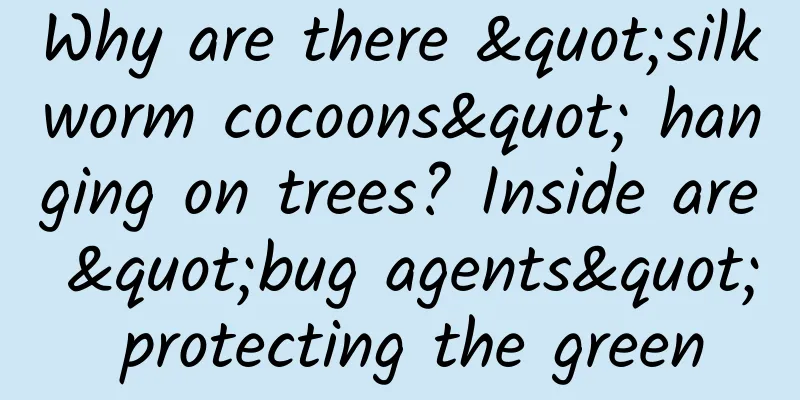Why are there "silkworm cocoons" hanging on trees? Inside are "bug agents" protecting the green

|
As the weather gets warmer, some trees have small paper bags or "cocoons" that release natural enemies of pests. What natural enemies of pests are currently being artificially bred? Can "using insects to control insects" replace pesticides? Written by reporter Ding Lin Editor/Ding Lin New Media Editor/Lv Bingxin Expert interviewed: Zhang Fan (Researcher at the Institute of Plant Protection, Beijing Academy of Agricultural and Forestry Sciences) It is the hottest and most humid days of the year in many places. High temperature and high humidity create a good water and heat environment for plant growth, but also provide a breeding ground for pests. Therefore, this period is also a critical period for insect prevention and control of flowers, trees and field crops. Careful people will find that since the beginning of summer, some roadside trees or garden plants have been nailed with a white card with a ladybug pattern printed on it, while others have been hung with a packet of "cold granules". It turns out that these are release devices for natural enemies of pests such as Harmonia axyridis and predatory mites. The biological control technology of "using insects to control insects" by using natural enemies of pests is an effective way to reduce the use of pesticides and promote green plant protection. △ A biological control "bug card" hung on a tree in Chaoyang District, Beijing, with Harmonia axyridis eggs attached to the inside. Harmonia axyridis is a broad-feeding beneficial insect that can kill a variety of pests (Photo: Ding Lin) Biological control technology in agricultural production in China has a long history. In addition to observing the mutual restraint relationship between organisms, my country is also one of the earliest places in the world to carry out biological control. In the "Southern Plants and Trees" of the Western Jin Dynasty, there are records of using yellow ants to control citrus pests and selling yellow ant nests as commodities. This is the earliest historical record of "using insects to control insects" in the world. During the Ming and Qing dynasties, the Lingnan region not only expanded the scope of control of the yellow macaque ant to include citrus, orange, grapefruit, lemon and other fruit trees, but also developed methods such as "bamboo indexing" and "vine and bamboo guidance" to allow the yellow macaque ants to "move in and out and connect trees", improving the control effect. △Yellow ant (Photo credit: Reynante Martinez/iNaturalist, CC BY) In recent years, with the improvement of people's living standards, people's expectations for ecological environment quality and food safety have continued to increase, and the demand for biological control has also increased. Parasitic and predatory enemies Chemical pesticides are an indispensable and important means of plant protection, but their harm to the environment and agricultural products cannot be ignored. If used for a long time, the resistance of pests will continue to increase. Therefore, scientists use the law of "one thing subdues another" in nature to find new breakthroughs in the field of biological control. The natural enemies of pests can be divided into two categories: parasitic and predatory. Parasitic natural enemies, such as various parasitic wasps, will lay their eggs inside the eggs, larvae or pupae of pests. After the parasitic wasps hatch, their larvae will develop and grow inside the eggs, larvae or pupae of the pests, strangling the pests in the "germination stage" and preventing them from multiplying in large numbers. Predatory natural enemies either eat the pests directly (such as using ladybugs to control aphids) or suck the pests' body fluids to kill them (such as using predatory mites to control spider mites). They mainly target aggregating pests such as aphids. △ Harmonia axyridis has many variations in back patterns, some of which are shown in the picture (Photo credit: James Bailey /iNaturalist, CC BY-NC) For different pests, plant protection researchers will determine the most suitable biological control natural enemies based on actual observations and research. For example, Zhou's gnawing wasp is a parasitic natural enemy of the gypsy moth (a leaf-feeding forest pest) that was selected and bred by Chinese researchers after years of exploration. The gypsy moth is a major invasive alien species and a typical omnivorous pest that can harm more than 80 plant species in Beijing. It has the characteristics of large reproduction, strong adaptability, and disturbing people at home. Zhou's gnawing wasp can parasitize in the pupae of the gypsy moth and reproduce a generation in about 20 days. The new wasps can independently find gypsy moths to parasitize. In addition, longhorn beetle-type trunk-boring pests, represented by the two-striped cedar longhorn beetle, pose a serious threat to the normal growth of some trees. Longhorn beetles are described as "fires without smoke". Although they are not as conspicuous as aphids and caterpillars, their larvae will hide in the trunks and chew out winding tunnels, seriously affecting the growth of trees. Artificially released natural enemies such as swellleg wasps and flower beetles will drill into the longhorn beetle tunnels, look for longhorn beetle larvae and lay eggs to parasitize, thus achieving a control effect. It is reported that these "bullfighters" are released in relatively large quantities in parks with many ancient trees and famous trees, such as the Summer Palace and the Temple of Heaven. △Release the flower beetle on the tree (Photo source: Beijing Evening News) In addition to protecting urban gardens, biological control is also widely used in the agricultural field, such as using the aphid wasp to prevent whiteflies, the small flower bug to prevent thrips, and the ladybug to prevent aphids. "Organic vegetables grown in facilities can completely control all pests through biological control measures such as natural enemies," Zhang Fan, a researcher at the Institute of Plant Protection, Beijing Academy of Agricultural and Forestry Sciences, told reporters. Why were they chosen? In order to achieve "controlling pests with insects", researchers first look for natural enemies of pests in nature. But finding natural enemy resources does not mean everything is fine. Plant protection personnel often need to artificially breed these natural enemy species to increase their lethality. Without intervention, in the later stages of an insect infestation, the number of local natural enemy species will naturally increase due to sufficient food, but at this point the damage done by pests to crops, trees and other resources is irreversible. Therefore, the strategy of biological control is to scientifically predict and release natural enemies of pests in advance at the early stages of an insect infestation. When it comes to natural enemies of pests, many people will first think of spiders, mantises and other animals. Why are the little-known predatory mites and Zhou's wasps chosen? This is also related to the feasibility of large-scale breeding. Most natural enemy species cannot be artificially bred on a large scale, and only a few have achieved large-scale commercial applications. Large-scale breeding of beneficial insects is not as simple as it sounds. Ordinary livestock can be fed with feed, but natural enemies of pests "love meat". It is impossible to breed pests in large quantities to feed them, right? Fortunately, researchers have found some alternatives, such as the Cucumber Mite, which can be raised by putting wheat bran, rice bran (food for the mite) and some mite (food for the Cucumber Mite) in the culture container. △ Such a white paper package contains more than 1,500 Amblyseius cucumeris mites and the "feed" to feed them (Photo: Ding Lin) Trichogrammatids are currently the most widely used biological control method in my country. On tens of millions of acres of land in Northeast China, they have effectively curbed agricultural pests such as corn borers and various rice borers. In the "natural enemy production workshop", people use tussah silkworm eggs and rice moth eggs to breed trichogrammatids. "This solution was found after several generations of hard work," said Zhang Fan. In addition to achieving large-scale breeding, how to quickly accumulate a certain number of natural enemies during the pest outbreak season, which age of natural enemies are more lethal and more resistant to low-temperature storage, etc., are also issues that plant protection researchers need to study and explore. In order to prevent the artificially cultivated natural enemy species from degenerating after multiple generations, regular purification and rejuvenation are also required in breeding work. After the natural enemies of pests are mass-produced, the artificial release of these biological control "pioneers" to quickly find the pests must also follow science. The timing of release depends not only on the time of the pest outbreak, but also on the age of the pest. For example, trichogrammatids parasitize in the eggs of pests, so it is best to release them when the pests are about to lay eggs or in the early stage after laying eggs. △The gypsy moth is a serious invasive species. The summer climate is conducive to their growth and reproduction, and after the summer, the forests are repeatedly washed by rain, which weakens the effect of drug control. In September every year, the third generation of gypsy moth larvae will reach the peak of damage (Photo source: Beijing Daily) Will breeding and releasing pests' natural enemies in large numbers destroy the ecological balance? There is no need to worry too much about this. Each natural enemy has a certain "dietary preference". When pests are eliminated in large numbers, the population of natural enemies will also decrease due to "food shortage" and will not pose a threat to the ecology. Sometimes, in order to retain natural enemies, plant protection workers have to make extra efforts. For example, after the pests in the vegetable field have eaten, the released ladybugs may fly away. Without intervention, it will be difficult for the ladybugs to establish. For this reason, plant protection workers will add "proliferation plants" such as wheat to the vegetable fields - wheat aphids will not harm vegetables, but they can allow the ladybug population to stay stably in the vegetable fields and "look for aphids everywhere", and continue to play a role. Other proliferating plants include flowers that can attract natural enemies to visit and reproduce. However, it is worth noting that although introducing natural enemies from other places can improve and strengthen the local natural enemy composition or deal with newly imported pests, it is not always safe to introduce natural enemies. For example, Harmonia axyridis is an important biological control insect in East Asia, but after being introduced to Europe and North America, it has grown and gradually replaced the local ladybug species and become an invasive species. "So we have to be extra careful when introducing species. The natural enemies of local species are not a big problem," said Zhang Fan. △Beijing's "Technical Specifications for the Breeding and Release of Predatory Natural Enemies" lists various artificially bred predatory natural enemies currently used in agricultural and forestry production in the city (excluding parasitic natural enemies) Can “using insects to control insects” replace pesticides? Although biological pest control has many advantages over pesticides, it also has some disadvantages, such as a longer pest control period and not as convenient as applying pesticides. It is difficult to replace pesticides in the short term. Even so, biological control is still very meaningful from the perspective of reducing the use of pesticides. Zhang Fan believes that in a few places or when the planting area is small, biological control can sometimes be used alone, such as in greenhouses in the Netherlands, where biological control programs have been very successful. However, large-scale replacement is not yet very realistic. However, for some pests that are difficult to control with pesticides, using natural enemies can greatly improve the control effect. For example, when corn borers grow to a high age, it is difficult to control them with drugs; fruit borers will also hide in the fruit in the later stage, so the control effect of pesticides is reduced. In these scenarios, if natural enemies such as parasitic wasps are used to kill eggs, the pest pressure can be reduced. △At the site of the American white moth control work in the Olympic Village, a large pesticide sprayer is spraying pesticides on trees (Photo source: Chaoyang District Gardening and Greening Bureau) "We have done a lot of experiments to determine whether various pesticides are highly toxic, moderately toxic, low-toxic, or non-toxic to natural enemies of specific pests," said Zhang Fan. With these data, low-toxic and non-toxic pesticides can be used in combination with natural enemies in practice. On the other hand, it is also possible to not apply pesticides for a period of time before and after releasing natural enemies to coordinate the effects of the two control measures. The popularization of biological control technology is a long and arduous task. Its wider application requires not only a breakthrough in the technical barrier of production, but also more policy support and market acceptance. Beijing is at the forefront of the country in the industrialization of beneficial natural enemies. According to information released by the Publicity and Education Center of the Beijing Municipal Bureau of Agriculture, the output value of related enterprises in the city exceeded 100 million yuan in 2020. There are 20 natural enemy production enterprises in total, and 24 biological natural enemy production lines have been built, with an annual production capacity of more than 300 billion heads. In recent years, Beijing has also vigorously promoted the application of biological natural enemies in agriculture. From 2017 to 2019, the city promoted and applied natural enemies to control pests on 1.123 million mu of land, of which 560,000 mu were used for vegetable pest control. The coverage rate of natural enemy application in facility vegetable production reached 64%, effectively ensuring the quality and safety of agricultural products in Beijing. Produced by: Science Central Kitchen Produced by: Beijing Science and Technology News | Beijing Science and Technology Media Welcome to share to your circle of friends Reproduction without authorization is prohibited |
Recommend
A Guide to Avoiding Pitfalls in Event Operations
Sales promotion is the most common means of onlin...
How much is the market price for a pound of bull whip? How much does a pound of bull whip cost now?
Influenced by traditional Chinese culture, people...
The 2021 Beijing Science Carnival is here! A variety of scientific activities to explore in one picture
The 2021 National Science Popularization Day Beij...
New policy on subsidies for rural veterans turning 60 in 2022: How much per month?
In order to protect the quality of life of vetera...
How did people keep warm before cotton was introduced to China?
Author: Duan Yuechu Throughout human history, res...
A miracle happened! The sperm whale returned home! Why do whales get stranded?
Expert of this article: Liu Yadan, former assista...
The big-screen phone bet is right! iOS has reversed its global market share
[[125989]] Last year, Apple released two large-sc...
From 0 to 1, how to carry out overseas operations and promotion?
Establish a promotion and operation system around...
Brain death may not be true death? The blurring boundary of death
Author: Global Science Mechanisms for coping with...
What happens in the body when you have diarrhea? Why can you walk a thousand miles if you hold your urine, but you can't walk an inch if you have diarrhea?
There are always moments in life when you need to...
3 templates for high-conversion promotion ideas!
How to write a stunning opening for your creative...
There are 5 super carcinogens hidden around us. Check if you eat them often!
Have you ever paid attention to the carcinogens a...
The transformation of a media giant: the inside story of Shanghai Media Group's 100 billion yuan integration
On the 23rd floor of the Shanghai Vision Building...
WeChat friend deletion detection coming soon? Tencent releases patent for "one-way friend detection"
When a friend is deleted from WeChat, you will no...
Brand marketing planning basics
Think about two questions first. 1. What is a bra...









